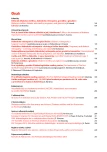-
Medical journals
- Career
First outcomes of The First Ophthalmological Reading Centre
Authors: Emil Martinka 1; Marta Ondrejková 2; Eva Fabiánová 1; Denisa Křivánková 1; Monika Gajdošová 3
Authors‘ workplace: Národný endokrinologický a diabetologický ústav, n. o., Ľubochňa 1; II. Očná klinika SZU a FNsP F. D. Roosevelta v Banskej Bystrici, prednostka MUDr. Marta Ondrejková, PhD. 2; Očné centrum OFTAL s. r. o, Špecializovanej nemocnice v odbore oftalmológia vo Zvolene, primárka MUDr. Monika Gajdošová 3
Published in: Forum Diab 2013; 2(3): 192-198
Category: Main Theme: Original Paper
Overview
Results of a pilot study showed that the incidence of pathological retinal findings associated with diabetes mellitus was higher than reported figures NCZI, but at the same time lower (at least in patients with type 1 diabetes) than that given literary sources. This fact can be evaluated positively, pointing to an overall good care of both the diabetologists and ophthalmologists. On the other hand, a relatively high incidence of pathological findings on the eye fundus during the first five years of the type 2 diabetes points to the need for improvement of earlier diagnosis of diabetes and may also indicate a lack of intensity of glycaemic control during the initial years of the disease. Differences in the incidence of retinal findings customarily referred among patients with type 2 diabetes duration 5, respectively 10 years, and in incidence of findings in ORC suggest delayed ophthalmological examinations and lack of their frequency in the early years of the disease.
These findings substantiate the need for intensive screening for diabetes mellitus in the primary sector and timely transmission to diabetologist and ophthalmologist as well as the need for the availability of modern therapeutical benefits already in early stages of diabetes mellitus. The surprising findings were quite common differences between the original findings on the eye fundus from patient records and findings from ORC (21.6 %). Although in many cases it was a finding that may have been associated with the progression of fundus finding were captured and the other findings and only 22 (7.1 %) cases were new onset DM. All these findings confirm the importance of the existence and creation of new “Reading ophthalmic centers” and close cooperation between Diabetologist and Ophthalmologist.Key words:
diabetic macular edema – diabetes mellitus-incidence – diabetic retinopathy
Sources
1. Dodson P. Diabetic retinopathy: treatment and prevention. Diab Vasc Dis Res 2007; 4(Suppl 3): S9-S11.
2. Klein R, Klein BE, Moss SE et al. The Wisconsin Epidemiologic Study of Diabetic Retinopathy: XVII. The 14-year incidence and progression of diabetic retinopathy and associated risk factors in type 1 diabetes. Opthalmology 1998; 105(10): 1801–1815.
3. Martinka E. Prvé výsledky štúdie ESKULAP. XXIII. Diabetologické dni Bratislava 2013. Prednáška.
4. NCZI Dostupné z WWW: <http://www.nczisk.sk/Documents/publikacie/2011/zs1211.pdf>.
5. Tapp RJ, Shaw JE, Harper CA et al. The prevalence of and factors associated with diabetic retinopathy in the australian population. Diabetes Care 2003; 26(6): 1731–1737.
6. Williams R, Airey M, Baxter H et al. Epidemiology of diabetic retinopathy and macular oedema: a systematic review. Eye (Lond) 2004; 18(10): 963–983.
7. Yau JWY, Rogers SL, Kawasaki R et al. Global prevalence and major risk factors of diabetic retinopathy. Diabetes Care 2012; 35(3): 556–564.
8. Zander E, Herfurth S, Bohl B et al. Maculopathy in patients with diabetes mellitus type 1 and type 2: associations with risk factors. Br J Ophthalmol 2000; 84(8): 871–876.
9. Ng DP. Human genetics of diabetic retinopathy: current perspectives. J Ophthalmol 2010. Dostupné z DOI: < http:// doi: 10.1155/2010/172593>.
Labels
Diabetology Endocrinology Internal medicine
Article was published inForum Diabetologicum

2013 Issue 3-
All articles in this issue
- Uncomplicated course of diabetic retinopathy during pregnancy: case report
- Anti-VEGF treatment of diabetic 1. type: case report
- Diabetes mellitus and glaucoma
- First outcomes of The First Ophthalmological Reading Centre
- Index of key words
- Why is the treatment of diabetes important a how can be achieved?
- Diabetic retinopathy 3: surgical treatment
- Pregnancy and diabetic retinopathy – screening and therapy: case report
- Forum Diabetologicum
- Journal archive
- Current issue
- Online only
- About the journal
Most read in this issue- Diabetic retinopathy 3: surgical treatment
- Diabetes mellitus and glaucoma
- Anti-VEGF treatment of diabetic 1. type: case report
- Why is the treatment of diabetes important a how can be achieved?
Login#ADS_BOTTOM_SCRIPTS#Forgotten passwordEnter the email address that you registered with. We will send you instructions on how to set a new password.
- Career
